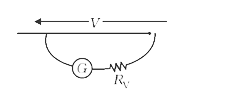A moving coil galvanometer, having a resistance G, produces full scale deflection when a current Ig flows through it. This galvanometer can be converted into
(i) An ammeter of range 0 to I0(I0>Ig) by connecting a shunt resistance RA to it and
(ii) Into a voltmeter of range 0 to V(V=GI0) by connecting a series resistance RV to it. Then
RARV=G2 and RARV=(IgI0−Ig)2
RARV=G2 and RARV=Ig(I0−Ig)RARV=G2(IgI0−Ig)
RARV=(I0−IgIg)2RARV=G2(I0−IgIg)
RARV=(Ig(I0−Ig))2
The correct Answer is:A
Ammeter

(I0−IG)RA=IGG (1)⇒I0RA=Ig(RA+G)
Voltmenter

V=Ig(Rv+G) (2)
⇒V−IgG=IgRV (3)
G(I0−Ig)=IgRv
(I0−Ig)RA=IgG
Dividing
GRA=RvG⇒RvRA=G2
From (1) RA=Ig.GI0−Ig
From (3) Rv=G(I0−Ig)Ig
RARv=I2g(I0−Ig)2
Similar Questions
A moving coil galvonometer of resistance RG gives a full scale deflection when a current Ig flows through its coil. It can be converted into an ammeter of range 0 to I(I>Ig) when a shunt of resistance S is connected across its coil. If this galvanometer is converted into an ammeter of range 0 to 2I, find the expression for the shunt required in terms of SandandRG.
View SolutionA galvanometer with a coil of resistance 10.0Ω shows full scale deflection for a current of 50mA. How will you convert the galvanometer into
(i). An ammeter of range 0 to 0.5 A and
(ii). A voltmeter of range 0 to 5V?
View Solution
Knowledge Check
A moving coil galvanometer, having a resistance G, produces full scale deflection when a current Ig flows through it. This galvanometer can be converted into [2019]
(i) An ammeter of range 0 to by connecting a shunt resistanceI0(I0>Ig) to it and
(ii) Into a voltmeter of range 0 to V(V=GI0) by connecting a series resistance to it. Then,ARARV=G2andRARV=(IgI0−Ig)2BRARV=G2andRARV=Ig(I0−Ig)RARV=G2(IgI0−Ig)CRARV=(I0−IgIg)2DRARV=⎛⎝⎛⎝Ig((I0−Ig))2RARV=G2(I0−IgIg)A moving coil galvanometer, having a resistance G, produces full scale deflection when a current Ig flows through it. This galvanometer can be converted into
(i) An ammeter of range 0 to I0(I0>Ig) by connecting a shunt resistance RA to it and
(ii) Into a voltmeter of range 0 to V(V=GI0) by connecting a series resistance RV to it. ThenARARV=G2I0−IgIg and RARV=(IgI0−Ig)2BRARV=G2 and π an RARv=IgI0−IgCRARv=G2 and RARv=(I0I0−Ig)2DRARV=G2(IgI0−Ig) and RARV=(I0−IgIg)2A galvanometer of resistance 15 ohm gives full scale deflection for a current of 2 mA. Calculate the shunt resistance needed to convert it into an ammeter of range 0 to 5 A
A0.712ohmB1.203ohmC0.006ohmD0.015ohm
A galvanometer coil has a resistance of 50 Ω and the meter shows full scale deflection for a current of 5 mA. This galvanometer is converted into voltmeter of range 0-20 by connecting
View SolutionA galvanometer coil has a resistance of 50Ω and the meter shows full scale deflection for a current of 5 mA . This galvanometer is converted into a voltmeter of range 0 - 20 V by connecting
View SolutionA galvanometer of resistance 15Ω gives full scale deflection for a current of 2mA. Calculate the shunt resistance needed to convert it into an ammeter of range 0 to 5A.
View SolutionA galvanometer of resistance 100Ω gives full scale deflection for the current of 0.1 A . The series resistance required to convert it into voltmeter of range 100 V is
View SolutionA moving coil galvanometer of resistance 40 Ω gives full scales deflection when a current of 0.25 mA is paased through it. To convert it to voltmeter of range 10 V, the resistance requried to be placed in series is
View Solution

